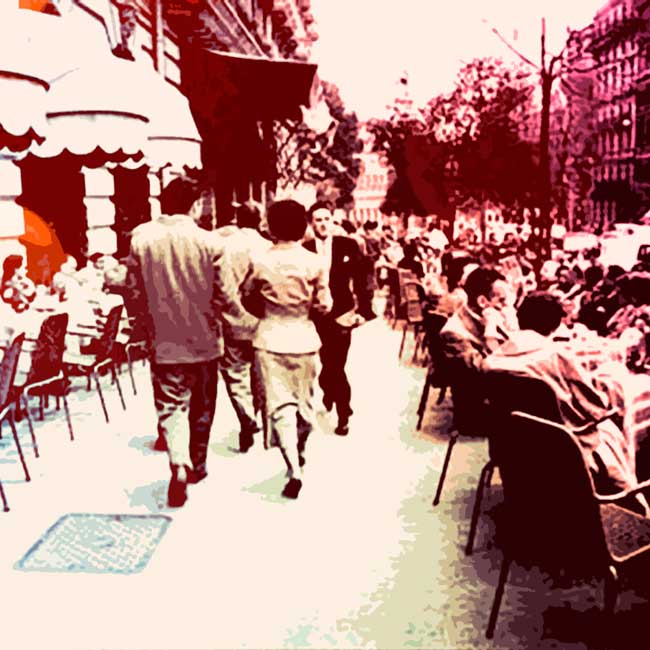La dolce vita, night spots and high society

In Rome, it was primarily Cinecittà that dictated the rules, and the nightclubs became hangouts for actors, directors, singers, and the affluent in general. The clientele was often foreign and chose venues like the Brick Top, the club owned by Ada Smith (1894-1984), better known in Europe and the USA as Bricktop, for her brick-coloured hair. She was born in Alderson, West Virginia, in 1854. In 1924, she moved to Paris and devoted herself to the night club scene. She was the one to launch the fashion of the Charleston in the French capital […] Joséphine Baker was one of her dearest friends […] They later met up again in Rome, where in the 1950s, Ada Smith opened her enth Brick Top club at number 155 on Via Veneto. It was in that very club, on the night between August 15 and 16, 1958, that a group of photographers, who had followed Ava Gardner and Anthony Franciosa on their way into the club, shot one of the Dolce Vita’s first lively brawls during that “encounter”. Every night at the Brick Top, the most exotic American fantasies became reality, in a world of shady gangsters and maniacal jazz men. The atmosphere evoked “tough guys” and Mickey Spillane novels […] Over the years, many famous names sat at that club’s tables, including Frank Sinatra, who usually left mind-boggling tips, as much as one hundred, two hundred dollars […]
As a kid, the pianist Stelvio Cipriani –composer, among other things, of the soundtrack for the film The Anonymous Venetian and one of the first Italian piano bar musicians – also hung around the club, fascinated by the bravura of Charlie Beal, the famous African-American pianist. A disciple of Dave Brubeck, Cipriani played for years on cruise ships, particularly the Homerick, which sailed between New York and the Caribbean […]
It was with Cipriani, and earlier still with singer and pianist Mario Perrone, that the piano bar phenomenon was born in our country, and would eventually knock the steam out of our Cocktail Music. The first Italian piano bar opened in Rome in the early 1950s on the ground floor of the Hostaria dell’Orso, on Via di Monte Brianzo. It was called Blue Bar and featured Mario Perrone, indisputably the genre’s first pianist and singer […] At the Grotte del Piccione, the Kit Kat, Club 84 and many other Italian clubs, Perrone wowed audiences with an explosive and unforgettable mix of the Twist, the Cha Cha Cha, the Bossa Nova and the Hully Gully.
Club 84 is one of the best known clubs of the Dolce Vita. It opened in 1957, when Oliviero Comparini, known simply as Oliviero, took over the Victor Bar from Tombolini […]. From Fred Bongusto to Bruno Martino, Peppino Di Capri, and Armandino, so many artists performed on the club’s tiny stage. Audiences were captivated by Armandino’s guitar, and his seamless alternation between Neapolitan songs and Latin American rhythms. From 1943 to 1944, the guitarist played with Marino Marini’s orchestra, another undisputed king of Italian nightclubs, performing primarily in clubs frequented by American soldiers. He then joined Van Wood’s band and in 1953, formed a small orchestra. In the 1950s and ‘60s, he became one of the biggest names in Roman nightlife, performing in venues like the Pipistrello, the Capriccio, the Rupe Tarpea, the Casina Valadier and the Casina delle rose.
However, those who loved to party until dawn went to the Kit Kat, a Roman nightclub at the end of Via Emilia appropriately nicknamed “the last resort club”. In fact, it was the last to open and the last to close; the clientele generally arrived around 11 pm and usually didn’t leave before 6 am […] Playing there were orchestras like the Flippers with Massimo Catalano, Franco Bracardi and Fabrizio Zampa […].
At the Grotte del Piccione, the well-known club on Via della Vite in Rome, instead Don Marino Barreto Jr. was taking the stage […], one of the greatest post-war crooners, with his low, often hoarse voice performing classics like Arrivederci or Angeli negri. His name was also linked to Mina’s, who in the summer of 1958 made her debut with the song Un’anima pura proprio in the wake of a performance by Don Marino Barreto Jr. at the Bussola in Marina di Pietrasanta.
Excerpt from Francesco Adinolfi, Mondo exotica. Suoni, visioni e manie della Generazione Cocktail, Einaudi: Turin, 2000.
